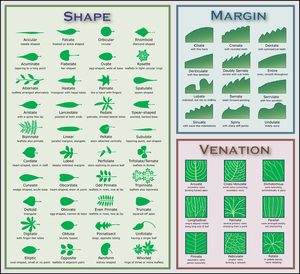Leaf
Venation

Venation is the pattern of veins in the blade of a leaf. The veins consist of vascular tissues which are important for the transport of food and water. Leaf veins connect the blade to the petiole, and lead from the petiole to the stem. The two primary vascular tissues in leaf veins are xylem, which is important for transport of water and soluble ions into the leaf, and phloem, which is important for transport of carbohydrates (made by photosynthesis) from the leaf to the rest of the plant.
The venation pattern of a leaf is classified as reticulated, parallel, or dichotomous. In reticulated venation, the veins are arranged in a net-like pattern, in that they are all interconnected like the strands of a net. Reticulated venation is the most common venation pattern, and occurs in the leaves of nearly all dicotyledonous Angiosperms, whose embryos have two cotyledons (seed leaves) as in flowering plants such as Maple, Oak, and Rose. In parallel venation, the veins are all smaller in size and parallel or nearly parallel to one another, although a series of smaller veins connects the large veins. Parallel venation occurs in the leaves of nearly all monocotyledonous Angiosperms, whose embryos have one cotyledon, as in flowering plants such as lilies and grasses. In dichotomous venation, the veins branch off from one another like the branches of a tree. This is the rarest venation pattern, and occurs in the leaves of some ferns and in the gymnospermtree, Ginkgo biloba.
Additional topics
Science EncyclopediaScience & Philosophy: Laser - Background And History to Linear equationLeaf - Blade, Venation, Anatomy, Epidermis, Mesophyll, Veins, Phyllotaxy, Evolution - Morphology